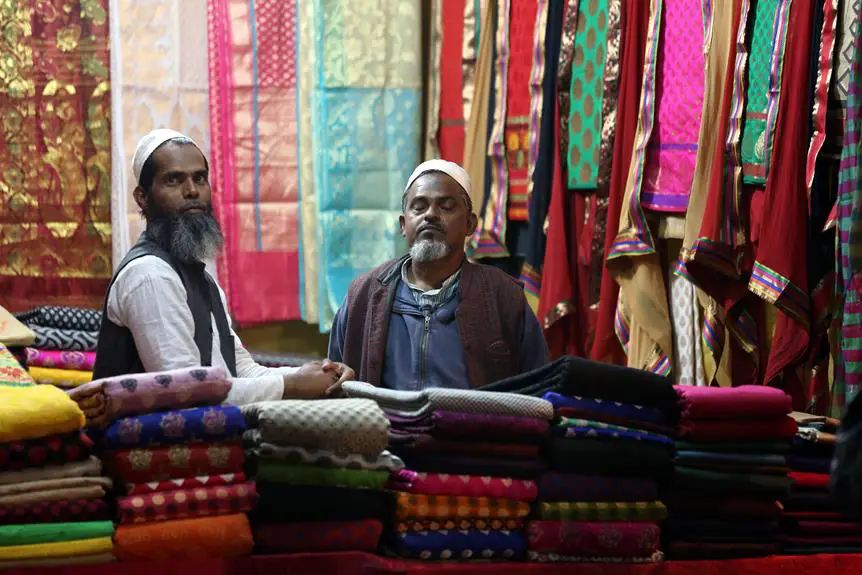Are spinning and weaving the key to quality fabrics?
Delve into the intricate world of textile production, where the art of spinning and the evolution of weaving techniques play pivotal roles in creating superior fabrics.
Understanding yarn quality and the impact of weaving patterns is essential for mastering the art of textile creation.
Innovations in spinning technology and weaving for fabric strength further elevate the standards of excellence in the industry.
Explore the sustainable aspects of spinning and weaving, and unlock the secrets behind producing fabrics of unparalleled quality.
Key Takeaways
- Understanding different types of fibers and their properties is crucial in selecting the right fiber for a project.
- Evaluating yarn quality, including its strength and ability to withstand tension, is important for fabric durability and dye absorption.
- Weaving patterns have a significant impact on fabric quality, including texture, strength, drape, and breathability, as well as sustainability implications.
- Innovations in spinning technology, such as high-speed spinning and air jet spinning, can result in superior quality textiles with increased strength and consistency.
The Art of Spinning
In the art of spinning, you need a good understanding of the different types of fibers and their properties to create high-quality yarn. The first step in mastering the art of spinning is selecting the right fiber for your project. Different fibers have unique characteristics that affect the yarn they produce.
For instance, wool is known for its elasticity, making it suitable for resilient yarn, while silk creates a luxurious, smooth yarn. Once you've chosen the appropriate fiber, it's essential to employ the right spinning techniques. Whether you're using a drop spindle or a spinning wheel, understanding how to draft the fibers and control the twist is crucial to producing the desired yarn.
Practice and experimentation with various spinning methods will help you refine your skills and achieve consistency in the yarn you create. Additionally, learning about fiber preparation, such as combing or carding, can further enhance the quality of the yarn you produce.
Mastering the art of spinning involves a deep understanding of spinning techniques and fiber selection, allowing you to create yarn that meets the highest standards of quality and craftsmanship.
Evolution of Weaving Techniques
To master the art of weaving, you need to understand the evolution of weaving techniques, which have been shaped by centuries of innovation and creativity. Weaving innovation is a result of ancient techniques that have been refined and improved over time. The table below provides a glimpse into the evolution of weaving techniques, showcasing the progression from ancient methods to modern innovations.
| Ancient Techniques | Modern Innovations |
|---|---|
| Backstrap weaving | Computerized looms |
| Warp-weighted looms | Jacquard looms |
| Heddle rod technology | Air-jet weaving machines |
| Pit looms | Water-jet looms |
| Handloom weaving | Shuttleless looms |
Understanding the evolution of weaving techniques allows you to appreciate the rich history and the technological advancements that have led to the high-quality fabrics available today. By studying the progression from ancient methods to modern innovations, you can gain insights into the intricate craftsmanship and the dedication to weaving excellence.
Understanding Yarn Quality
Understanding yarn quality is essential for anyone seeking to create high-quality fabrics through spinning and weaving. When evaluating yarn quality, consider the following:
- Yarn Strength
- Visualize the yarn being subjected to tension, and gauge its ability to withstand stress without breaking.
- Imagine the yarn being woven into a fabric, and envision how its strength contributes to the durability of the final product.
- Dye Absorption
- Envision the yarn soaking up dye, and visualize how evenly and deeply the color permeates the fibers.
- Consider the impact of dye absorption on the vibrancy and longevity of the fabric's color.
By understanding yarn strength, you can ensure that the fabric you create will be durable and long-lasting. Additionally, having a grasp of dye absorption properties allows you to predict how the fabric will take on color, leading to better control over the final aesthetic of the textile.
Mastering these aspects of yarn quality is crucial for achieving excellence in spinning and weaving, ultimately resulting in superior quality fabrics.
Impact of Weaving Patterns
When it comes to weaving patterns, the way the threads are interlaced can have a significant impact on the quality and characteristics of the fabric. Different weaving patterns can affect the strength, drape, and texture of the fabric, ultimately influencing its overall performance and appearance.
Understanding the influence of weaving patterns on fabric quality is essential for selecting the right type of fabric for specific applications and desired outcomes.
Weaving Pattern Influence
You can evaluate the impact of weaving patterns on fabric quality by considering the structure and interlacing of threads. The weaving pattern significantly influences yarn texture and weaving complexity, ultimately affecting the fabric's characteristics.
Consider the following:
- Yarn Texture:
- The weaving pattern determines how the yarn is interlaced, impacting the feel and appearance of the fabric.
- Different weaving patterns can create fabrics with varying degrees of smoothness, softness, and durability.
- Weaving Complexity:
- Certain patterns require more complex weaving techniques, resulting in intricate designs and textures.
- The complexity of the weaving pattern can affect the fabric's strength, drape, and breathability, contributing to its overall quality.
Fabric Quality Implications
The weaving pattern directly influences the quality of the fabric, impacting its texture, strength, and overall characteristics. Different weaving patterns result in varying fabric strengths. For example, plain weaves offer excellent durability, making them suitable for everyday use, while twill weaves provide a diagonal pattern that enhances flexibility and drapability.
Moreover, the weaving pattern affects the sustainability of the fabric. Certain patterns may require more yarn, resulting in increased material waste, whereas others can be more efficient in yarn usage, contributing to a more sustainable production process.
Understanding the implications of weaving patterns on fabric quality is crucial for selecting the most suitable material for specific applications, ensuring that the fabric not only meets but exceeds the desired standards for strength, sustainability, and overall performance.
Innovations in Spinning Technology
You'll discover the latest in advanced spinning techniques and how they've revolutionized the textile industry.
We'll explore the direct impact of these innovations on fabric quality, including enhanced strength and durability.
Additionally, we'll delve into sustainable spinning technologies and their potential to shape the future of textile production.
Advanced Spinning Techniques
When exploring advanced spinning techniques, it's essential to consider the latest innovations in spinning technology.
- Advanced Techniques
- High-Speed Spinning: Cutting-edge spinning machines achieve higher spindle speeds, enhancing yarn production efficiency and consistency.
- Air Jet Spinning: This innovative technique uses compressed air to twist yarn, resulting in a softer and more uniform yarn with increased strength and reduced hairiness.
These advanced techniques have revolutionized the yarn production process, allowing for higher quality and more versatile yarn to be created.
As technology continues to advance, the potential for further innovations in spinning techniques holds great promise for the textile industry.
Impact on Fabric Quality
By implementing advanced spinning techniques, you can significantly improve the quality and durability of the fabrics you produce. Innovations in spinning technology have led to remarkable advancements in yarn composition and fabric texture, resulting in superior quality textiles. These advancements have allowed for the creation of yarns with precise characteristics, such as better tensile strength, reduced hairiness, and enhanced uniformity. Additionally, innovative spinning techniques have enabled the production of fabrics with improved texture, breathability, and drape. Below is a table highlighting the impact of advanced spinning techniques on fabric quality:
| Advancements in Spinning Technology | Impact on Fabric Quality |
|---|---|
| Enhanced yarn composition | Improved tensile strength, reduced hairiness |
| Superior fabric texture | Enhanced breathability, improved drape |
The continuous evolution of spinning technology plays a pivotal role in enhancing the overall quality and performance of fabrics.
Sustainable Spinning Innovations
Improving fabric quality through sustainable spinning innovations is essential for meeting the demands of environmentally conscious consumers. Sustainable yarn and eco-friendly textiles are at the forefront of innovative spinning technologies, offering solutions to reduce the environmental impact of textile production.
- Sustainable Yarn: Imagine yarn made from recycled materials such as plastic bottles or discarded fabric, reducing waste and lessening the demand for virgin resources. This process involves advanced spinning techniques that transform recycled fibers into high-quality yarn suitable for premium fabrics, supporting a circular economy.
- Eco-Friendly Textiles: Envision fabrics created from organic and natural fibers, spun using energy-efficient methods that minimize water and chemical usage. These textiles promote sustainability throughout the supply chain, from spinning to weaving, resulting in high-quality, environmentally friendly products that meet the standards of discerning consumers.
Weaving for Fabric Strength
Strengthening fabric involves carefully selecting weaving techniques to enhance durability and resilience. The choice of weaving method significantly impacts the strength of the fabric. One of the most common techniques used to enhance fabric durability is the plain weave. This simple over-under pattern creates a strong and stable fabric, making it suitable for a wide range of applications.
Additionally, the twill weave, characterized by its diagonal line pattern, offers increased strength and flexibility, making it ideal for heavy-duty fabrics such as denim. Another technique, the satin weave, produces a smooth and lustrous fabric with long floats, resulting in a luxurious feel while still maintaining good strength.
Furthermore, the basket weave, which involves grouping yarns together, creates a robust and structured fabric commonly used in upholstery and heavy linens. Understanding these weaving techniques and their impact on fabric durability empowers you to make informed decisions when selecting or creating high-quality, long-lasting textiles.
Spinning and Weaving Sustainability
To ensure sustainability in spinning and weaving, you need to consider the environmental impact of the materials and processes used. Embracing sustainable practices in spinning and weaving involves ethical sourcing and minimizing the carbon footprint.
Here's how you can achieve sustainability in these processes:
- Ethical Sourcing
- Choose natural and organic fibers sourced from responsible and sustainable suppliers. This includes materials like organic cotton, hemp, and linen, which are grown without harmful pesticides and chemicals, promoting environmental conservation.
- Consider the welfare of workers involved in the sourcing and production of materials. Ensure fair labor practices and good working conditions, supporting social sustainability.
Frequently Asked Questions
How Does Spinning and Weaving Contribute to the Overall Sustainability of the Textile Industry?
Spinning and weaving contribute to the overall sustainability of the textile industry by reducing environmental impact through sustainable practices. These processes optimize material use, minimize waste, and support eco-friendly production methods.
What Are the Potential Health Benefits of Using Fabrics Created Through Traditional Spinning and Weaving Techniques?
Using fabrics created through traditional spinning and weaving techniques can have potential health benefits. These ancient practices are believed to contribute to improved well-being by producing textiles that are breathable, comfortable, and free from harmful chemicals.
Are There Any Cultural or Historical Significance Associated With Specific Spinning and Weaving Techniques?
Cultural significance and historical techniques play a crucial role in specific spinning and weaving methods. Understanding the traditional practices and their significance helps preserve cultural heritage and craftsmanship, contributing to the appreciation of textile artistry.
How Do Spinning and Weaving Techniques Affect the Overall Cost and Availability of Quality Fabrics?
Spinning techniques and weaving processes directly impact the cost and availability of quality fabrics. Understanding these factors enables you to make informed decisions when selecting fabrics for your projects, ensuring the best outcome.
What Role Do Spinning and Weaving Play in the Production of Specialized or Niche Fabrics, Such as Those Used in Technical or Performance Applications?
In technical fabrics, spinning and weaving are vital. These techniques determine fabric properties crucial for performance applications. Specialized fabrics, like those for technical or performance uses, rely heavily on the precision of spinning and weaving processes.
- Why Is Red Velvet Not Red? - April 25, 2024
- How Do You Describe Velvet Fabric? - April 25, 2024
- How Strong Is Velvet? - April 25, 2024




